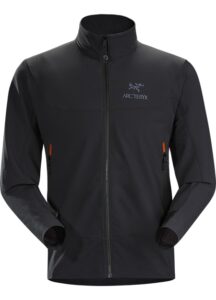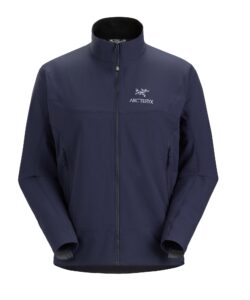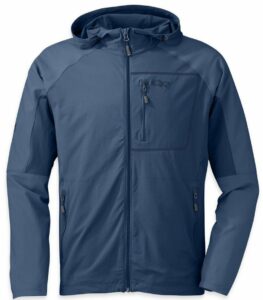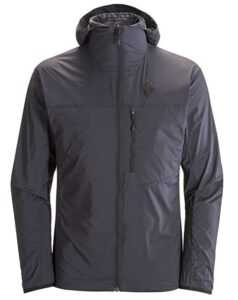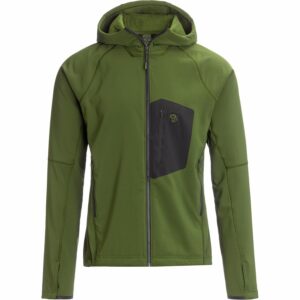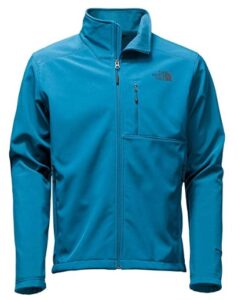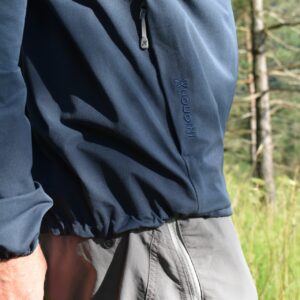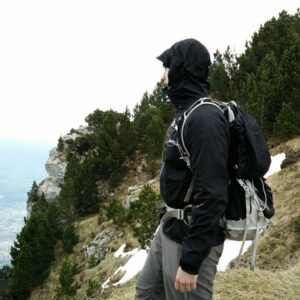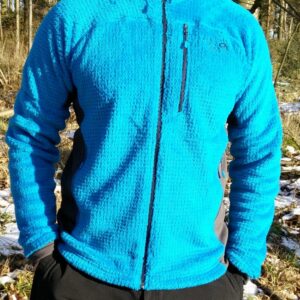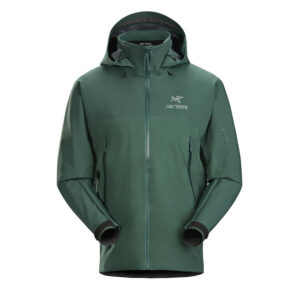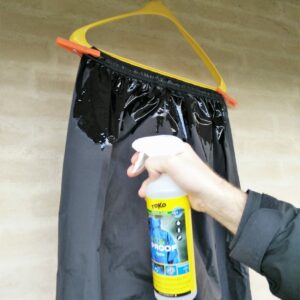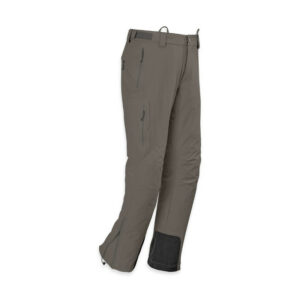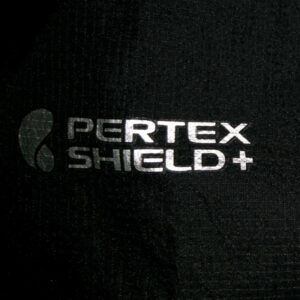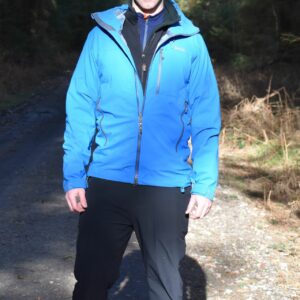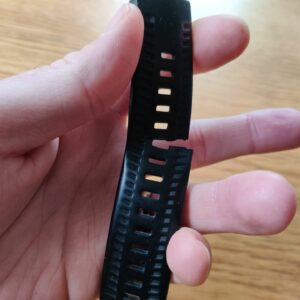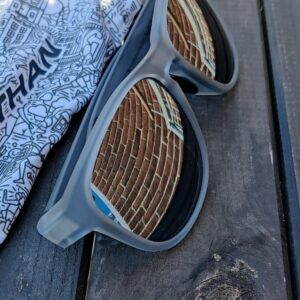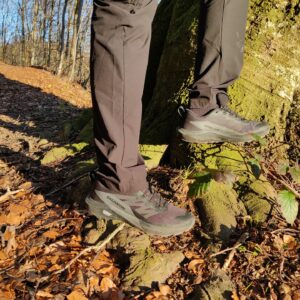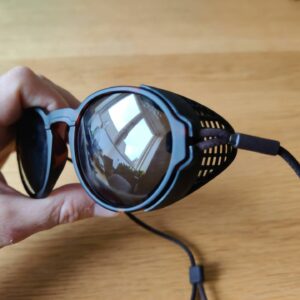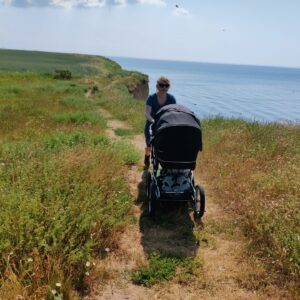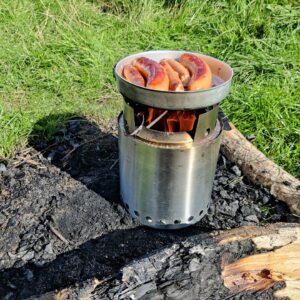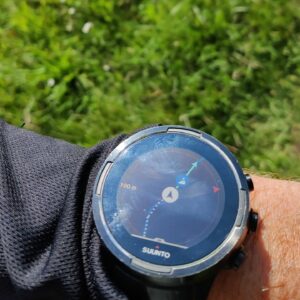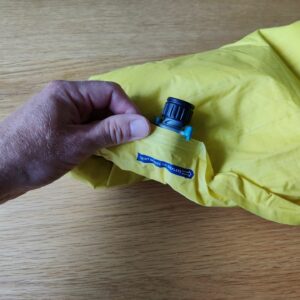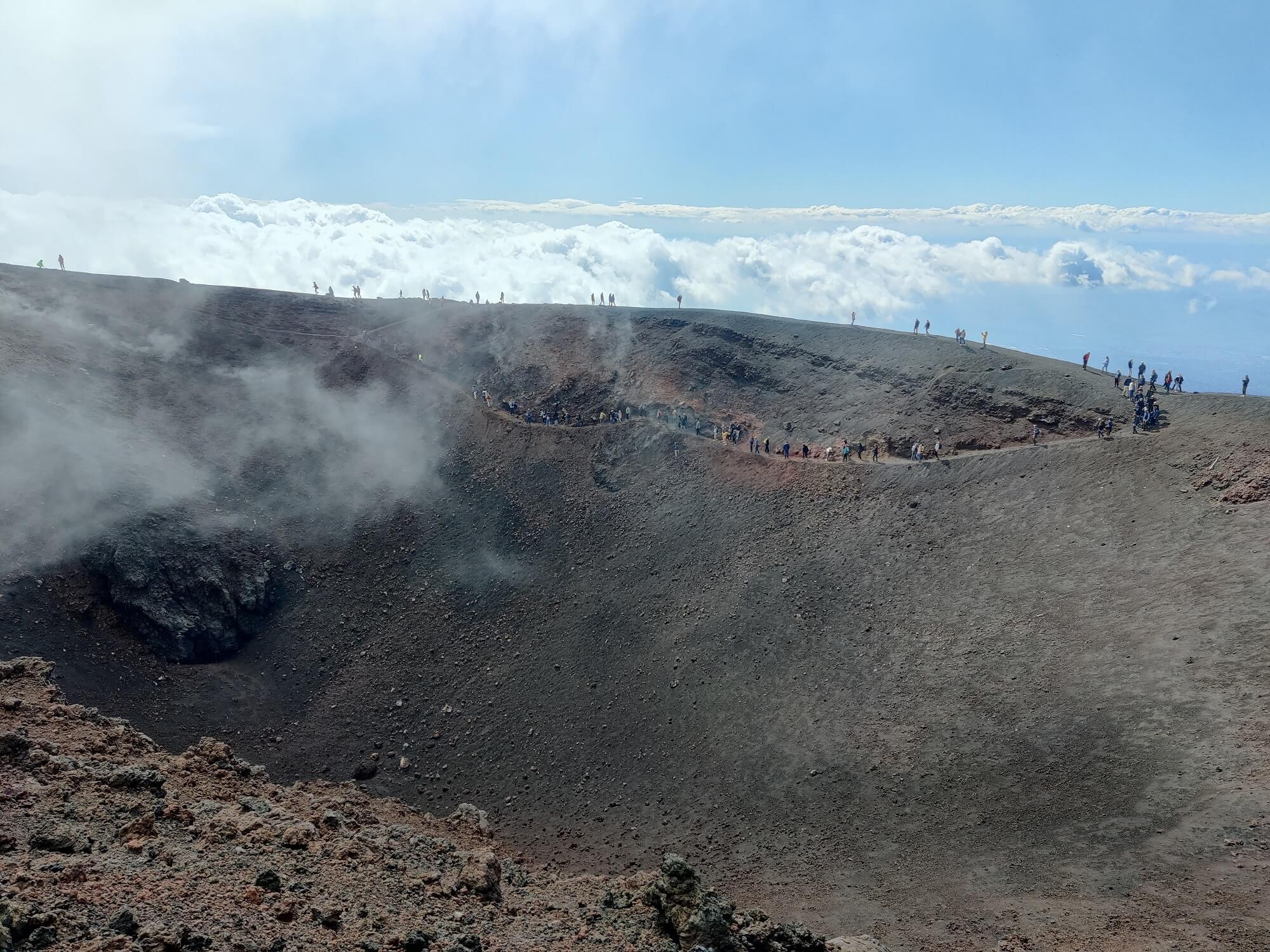Hiking in cold and windy weather is no fun unless you wear appropriate clothing which keeps you warm and snug. This includes a high-quality base layer, insulation layer and/or an outer layer. A softshell jacket is very useful as the outer layer because it provides both insulation and protection against the wind and light rain.
Here we selected and reviewed the best softshell jackets to make your buying decision a little easier. We only listed products that offer great weather protection and breathability, but are lightweight.
As for insulation layers we also made a review of the Best Fleece Jackets. A fleece jacket can be worn under a softshell jacket in cold weather for more warmth. However, a softshell jacket can also be worn directly over a base layer in case that the extra insulation is not required.
Updated Content
We regularly update our reviews and selections to always recommend you the best products on the market.
Expert Selections
We only list top-tier products. Read how our selections of best hiking products differ from others here.
Links
We use affiliate links and may receive a small commission on purchases at no extra cost to you.
1. Our Softshell Jackets Picks
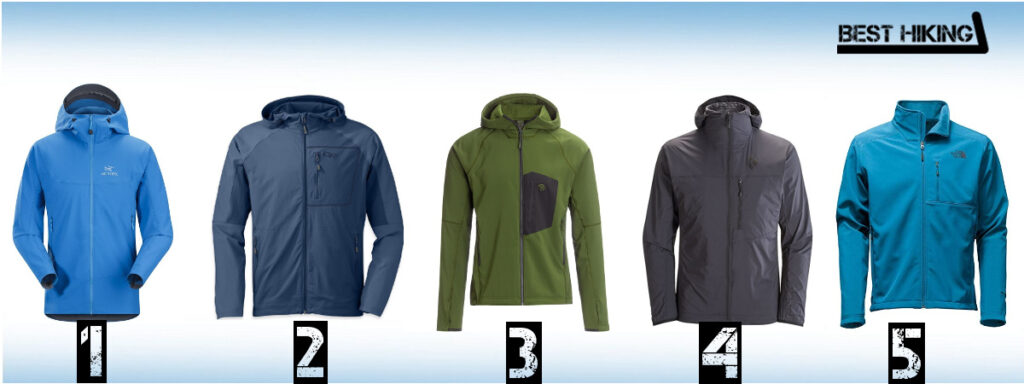
Best Softshell Jackets for Hiking
- Arcteryx Gamma LT Jacket
- Outdoor Research Ferrosi Jacket
- Black Diamond Alpine Start Jacket
- Mountain Hardwear Keele Hoody
- The North Face Apex Bionic 2
2. Comparison of Hiking Softshell Jackets
| Feature/Product | Arcteryx Gamma LT | Outdoor Research Ferrosi | Black Diamond Alpine Start Jacket | Mountain Hardwear Keele Hoody | The North Face Apex Bionic 2 |
|---|---|---|---|---|---|
| Weight | 16 oz. | 11 oz. | 9 oz. | 1 lb. | 1 lb. 8 oz. |
| Weight (Metric) | 445 g | 321 g | 250 g | 481 g | 680 g |
| Material | Wee Burly Softshell (56% Nylon, 34% Polyester, 10% Elastane) | 86% Nylon, 14% Spandex, Cordura | Schoeller (93% Nylon, 7% Elastane) | 90% Polyester, 10% Elastane | WindWall (96% Polyester, 4% Elastane) |
| Pockets | 3 | 3 | 1 | 3 | 3 |
| Available both with and without hood | Yes | Yes | Yes | Yes | Yes |
3. The Selection
1. Arcteryx Gamma LT
Suitable for:
- Hiking
- Mountaineering
- Trekking
- Backpacking
- Climbing
- Everyday use
The Arcteryx Gamma LT is an extremely durable softshell jacket which is best for those who need reliable and robust outerwear for their outdoor adventures. The jacket is made of Wee Burly softshell material which consists of two interlocking stretchy fabrics; the face fabric is made of nylon for protection against the abrasion and weather while the inner fabric is made of polyester which efficiently wicks moisture away from the base layer to keep you dry. The material is also treated with DWR (Durable Water Repellant) to additionally increase the rain resistance. As the material includes elastane fibers, Arcteryx Gamma LT offers great stretch and thus doesn’t restrict you when you are doing more technical things such as climbing. Freedom of movement is additionally increased with articulated pattering and underarm gussets. The jacket is also equipped with two zippered hand pockets, internal zippered pocket, hem drawcord, collar with soft lining and a front zipper which includes the No Slip Zip mechanism (prevents the zipper from self-opening). The pockets are placed a little higher than usual so that they allow easy access even when wearing a climbing harness or a backpack. The Arcteryx Gamma LT is available with and without a hood.
Women's Version: Available - Arcteryx Women's Gamma LT
Note: Women's version might slightly differ from the men's version.
Pros:
- Stretch
- Design
- Durability
- Functionality
Cons:
- /
2. Outdoor Research Ferrosi
Suitable for:
- Hiking
- Mountaineering
- Trekking
- Backpacking
- Climbing
- Everyday use
The Outdoor Research Ferrosi is a very light softshell jacket (it weighs merely 11 ounces) and is thus perfect for those who want to carry as little as possible on their hiking trips. Although the jacket is lightweight it offers superb performance. It is made of 90-denier nylon and features reinforced shoulders and lower sleeves. The reinforcements are made of the Cordura material which is known for being super light and very durable. Due to the sophisticated fabric the Ferrosi jacket also dries fast and offers good weather protection and breathability. The jacket features two zippered hand pockets, zippered chest pocket, adjustable hood and a drawcord hem. The hand pockets are placed slightly higher than usual to allow easy access when you are wearing a climbing harness. They are also equipped with coated zippers for better water resistance. The jacket is very stretchy and thus offers great freedom of movement. The Outdoor Research Ferrosi is an incredible jacket which ranks high in this selection. It is best for those who prefer lightweight gear for faster and easier ascents.
Women's Version: Available - Outdoor Research Women's Ferrosi
Note: Women's version might slightly differ from the men's version.
Pros:
- Weight
- Durability
- Fit
- Breathability
Cons:
- Thin
Where to buy?
Also available at:
3. Black Diamond Alpine Start Jacket
Suitable for:
- Hiking
- Mountaineering
- Trekking
- Backpacking
- Climbing
- Everyday use
The Black Diamond Alpine Start jacket is an incredibly light softshell jacket (the lightest in this review) and is thus very useful for highly aerobic activities such as mountaineering and ice climbing. The jacket is made of Schoeller softshell material which is not only very breathable and weather-resistant but also extremely durable (high tear-resistance). The material is also treated with DWR so that it repels the water rather than absorbing it. The Black Diamond Alpine Start jacket also features elastic cuffs, drawcord hem and underarm gussets for better freedom of movement. The jacket stows in the internal chest pocket for easy storing when not in use. The Black Diamond Alpine Start jacket is due to its low weight and small packed size a great option for those who often do physically demanding trips. However, keep in mind that the fabric is super thin and thus the jacket offers very little insulation.
Women's Version: Available - Black Diamond Women's Alpine Start Hoody
Note: Women's version might slightly differ from the men's version.
Pros:
- Weight
- Durability
- Breathability
- Weather protection
- Stretch
Cons:
- Thin
Where to buy?
Also available at:
Video

4. Mountain Hardwear Keele
Suitable for:
- Hiking
- Trekking
- Backpacking
- Everyday use
The Mountain Hardwear Keele Hoody is a bit heavier than the jackets listed above but on the other hand it also provides better insulation. The hoody is made of polyester and elastane and has a brushed fleece lining on the inside. The lining keeps you warm in cold conditions while the face fabric utilizes DWR treatment for good weather-resistance. The hoody has two zippered hand pockets, a zippered chest pocket, elastic cuffs and thumb holes. It also has a hem drawcord to lock out draughts. The collar is high and efficiently protects you against the elements, but the hood is not adjustable. It is, however, also available without a hood as well as in a half-zip version. Whatever you chose, the Mountain Hardwear Keele hoody is a great option for hiking, backpacking and everyday use.
Women's Version: Available - Mountain Hardwear Women's Keele Jacket
Note: Women's version might slightly differ from the men's version.
Pros:
- Weather protection
- Warmth
Cons:
- Hood is not adjustable
5. The North Face Apex Bionic 2
Suitable for:
- Hiking
- Trekking
- Backpacking
- Everyday use
The North Face Apex Bionic 2 jacket is another great option for hiking in quickly changing weather. The jacket is made of high-quality WindWall softshell material which is treated with DWR. Therefore, the North face soft cell jacket provides great protection against the weather but at the same time offers good breathability. The inner layer is made of a very soft fleece and thus offers great comfort and wicks moisture to the outside. The soft shell jacket has two zippered hand pockets, one zippered chest pocket and an adjustable hem. The North Face Apex Bionic 2 is a great jacket with one downside. It’s relatively heavy (it weighs 1 pounds and 8 ounces) and therefore it is mostly suitable for recreational hikers and everyday use.
Women's Version: Available - The North Face Women's Apex Bionic 2 Jacket
Note: Women's version might slightly differ from the men's version.
Pros:
- Fabric
- Durability
- Warmth
- Comfort
Cons:
- Weight
Where to buy?
Also available at:
4. Hiking Softshell Jacket Buying Advice – What is important?
Material:
A softshell jacket should provide insulation and protection against wind and light rain. It should be also breathable, lightweight, quick-drying and comfortable to wear. Softshell jackets normally consist of two fabrics which are bonded together; a polyester fleece fabric and a woven face fabric.
The face fabric is normally treated with fluorocarbon-based durable water repellent (DWR) which bonds to the fabric’s exterior. Due to the DWR-treatment, the face fabric repels the water instead of absorbing it. The DWR-treatment does not reduce the breathability of the fabric, but on the other hand DWR-treated fabrics can only resist water for shorter periods of time – not for daylong rain showers.
The polyester fleece fabrics on the inside of a jacket is usually relatively thin. It provides insulation by trapping the body-warmed air within its fibers. Furthermore, it also wicks moisture (perspiration) outwards to keep the inner layers close to the skin dry and warm. Some lightweight softshell jackets don’t have the polyester fleece fabric on the inside but instead use a very thin brushed lining.
For more information about materials check out our Comparison of Shell Materials and Comparison of Mid-layer Materials. To learn how to properly layer your clothes for hiking read our Hiking Clothing Guide.
Weight:
A softshell jacket for hiking should be lightweight so that it doesn’t slow you down on your trips. Softshell jackets in general have worse weight-to-warmth ratio than fleece jackets and rain jackets combined but on the other hand they also provide better breathability and are more comfortable to wear. Read more about why it is important to use lightweight gear in our article Why hike lightweight.
Pockets:
Because softshell jackets are worn as an outer layer they should be equipped with well-placed pockets. This allows you to keep your essential gear within easy reach.
5. Questions and Answers
What is the difference between a softshell jacket and a rain jacket?
Softshell jackets differ from rain jackets by being insulated (brushed surface or fleece on the inside), more comfortable (stretchy material) and more breathable. However, softshell jackets do not provide as good protection against rain as hardshell/rain jackets do. They are also heavier and dry slower. Nevertheless, softshell jackets are perfect for day hikes in quickly changing weather as they are very comfortable to wear, highly breathable and wind/rain-resistant. In moderate temperatures they can be worn directly over a base layer while they should be worn over a mid-layer in colder conditions.
Do softshell jackets have a membrane?
Some softshell jackets feature a wind-blocking membrane in addition to the DWR treated face fabric. Wind-blocking membranes differ from waterproof membranes (used in hardshells) by having much bigger micropores. Therefore, they do not decrease the breathability as much as waterproof membranes do, but they also don’t offer as good protection against the rain. Popular softshell materials which feature wind-blocking membranes are Gore Windstopper and Polartec Windblock.
Are softshell jackets windproof?
Yes, softshell jackets efficiently block the wind due to the tightly woven face fabric.
Are softshell jackets good for winter?
While softshell jackets do provide some insulation, they are not ideal for (cold) winter. They are best for fall and spring. In winter you will probably need a warmer garment such as a down jacket or a winter jacket with synthetic insulation.
Are softshell jackets waterproof?
No, softshell jackets are not waterproof, but they are water-resistant. They will keep you dry in light rain but not during heavy rain showers.
